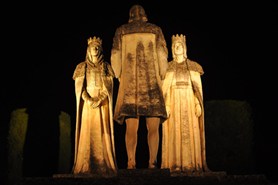Catholic Monarchs
 Ferdinand II of Aragon (1452-1516) and Isabella I of Castile (1451-1504) were married on 19 October 1469 in Valladolid. Their marriage sanctioned the dynastic union of the two kingdoms, although they retained legal and administration independence. Ferdinand and Isabella were both members of the House of Trastámara, descendants of John I of Castile, and were married through a papal dispensation by Sixtus IV. Another pope, Alexander VI, conferred upon them the title of “Catholic Monarchs”. During their reign some events of fundamental importance took place: the discovery of America (1492) and the end of the centuries-old process of the Reconquista, completed with the defeat of the last Muslim kingdom in the Iberian peninsula, the Nasrid kingdom of Granada (1492). Important consequences for the history of Spain ensued with the decision to expel the Jews (1492) and to proceed with the forced conversions of thousands of Muslims whom, from that time, were identified with the term Moriscos. The confessor of the Catholic Monarchs, the Dominican Tomás de Torquemada became the first General Inquisitor in charge of the Spanish Inquisition. Among their children, the only boy, John of Asturias, died before his parents (1497) and so it was Joana, married to Philip I of Habsburg, who took up the legacy of the Catholic Monarchs. The marriage between Joanna and Philip produced the future Emperor Charles V (1500-1558).
Ferdinand II of Aragon (1452-1516) and Isabella I of Castile (1451-1504) were married on 19 October 1469 in Valladolid. Their marriage sanctioned the dynastic union of the two kingdoms, although they retained legal and administration independence. Ferdinand and Isabella were both members of the House of Trastámara, descendants of John I of Castile, and were married through a papal dispensation by Sixtus IV. Another pope, Alexander VI, conferred upon them the title of “Catholic Monarchs”. During their reign some events of fundamental importance took place: the discovery of America (1492) and the end of the centuries-old process of the Reconquista, completed with the defeat of the last Muslim kingdom in the Iberian peninsula, the Nasrid kingdom of Granada (1492). Important consequences for the history of Spain ensued with the decision to expel the Jews (1492) and to proceed with the forced conversions of thousands of Muslims whom, from that time, were identified with the term Moriscos. The confessor of the Catholic Monarchs, the Dominican Tomás de Torquemada became the first General Inquisitor in charge of the Spanish Inquisition. Among their children, the only boy, John of Asturias, died before his parents (1497) and so it was Joana, married to Philip I of Habsburg, who took up the legacy of the Catholic Monarchs. The marriage between Joanna and Philip produced the future Emperor Charles V (1500-1558).
Read more:
- E. Belenguer Cebrià, Fernando el Católico. Un monarca decisivo en las encrucijadas de su época, Barcelona 2001.
- A. Alvar Ezquerra, Isabel la Católica. Una reina vencedora, una mujer derrotada, Madrid 2004.
- E. Belenguer Cebrià, Ferdinando e Isabella. I Re Cattolici nella politica europea del Rinascimento, Roma 2001.
